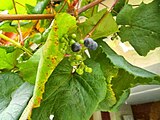bio.wikisort.org - Plant
Vitis coignetiae, called crimson glory vine, is a plant belonging to the genus Vitis that is native to the temperate climes of Asia, where it can be found in the Russian Far East, (Sakhalin); Korea; and Japan (Hokkaido, Honshu, Shikoku). It was described botanically in 1883.[1] It is called meoru (머루) in Korean and yama-budo (ヤマブドウ) in Japanese.
| Crimson glory vine | |
|---|---|
 | |
| Vitis coignetiae leaves | |
| Scientific classification | |
| Kingdom: | Plantae |
| Clade: | Tracheophytes |
| Clade: | Angiosperms |
| Clade: | Eudicots |
| Clade: | Rosids |
| Order: | Vitales |
| Family: | Vitaceae |
| Genus: | Vitis |
| Species: | V. coignetiae |
| Binomial name | |
| Vitis coignetiae | |
| Varieties | |
| Synonyms | |
|
V. amurensis var. glabrescens (Nakai) Nakai [possibly syn. of V. coignetiae var. glabrescens, not V. coignetiae][1][2] | |
History
The species name is dedicated to Mr. and Mrs. Coignet who reportedly brought seeds back from their trip to Japan in 1875.[citation needed]
This vine was also reported in 1884 snowy regions of Japan by Henri Degron sent to East Asia to seek wild vines resistant to Phylloxera. Degron sent specimens to a Professor Planchon of Montpellier who named them Vitis coignetiae but did not retain them due to their low resistance to phylloxera. Degron planted a vineyard in Crespières, Île-de-France where one of the vines reached a length of 32.8 meters and a height of 2.8 meter. In the cooler Norman climate the vine produces a bitter wine, rich in color and extract.[citation needed]
Description
The vine is very vigorous, with purple shoots. The deciduous leaves are large (15 to 30 cm in diameter), simple, orbicular, toothed, with deep petiole. First green, they turn red-orange in autumn.[citation needed]
Wild vines can be male, female or hermaphrodite. Clusters are large with small berries and large purple seeds. It is found in the mountainous regions of Japan and up to 1300 m altitude in Korea.[citation needed]
Uses

In East Asia it is grown as an ornamental plant for its crimson autumn foliage; and as an Oriental medicinal plant.[citation needed]
It is a recipient of the Royal Horticultural Society's Award of Garden Merit.[3]
It is used to produce wines in Korea and Japan. These are at first bitter, but softened with the addition of sugar.[citation needed]
Chemistry
The plant contains the stilbenoids ε-viniferin[citation needed] and rhapontigenin.[4]
Gallery
- Vitis coignetiae
 Vitis coignetiae leaves.
Vitis coignetiae leaves. Vitis coignetiae vine growing in Cheshire, United Kingdom.
Vitis coignetiae vine growing in Cheshire, United Kingdom. Vitis coignetiae fruit cluster.
Vitis coignetiae fruit cluster. Vitis coignetiae berries.
Vitis coignetiae berries.- The ornamental grape autumn colors. Growing in Victoria, Australia.
- Vitis coignetiae in Northern France.
See also
- Vitis 'Ornamental Grape', a nonfruiting ornamental grapevine cultivar, also known as 'crimson glory, grown for its autumn foliage
Sources
- "Vitis coignetiae". Germplasm Resources Information Network (GRIN). Agricultural Research Service (ARS), United States Department of Agriculture (USDA). Retrieved October 20, 2009.
- "Vitis coignetiae var. glabrescens". Germplasm Resources Information Network (GRIN). Agricultural Research Service (ARS), United States Department of Agriculture (USDA). Retrieved October 20, 2009.
- RHS Plants. Available at: https://www.rhs.org.uk/plants/19030/Vitis-coignetiae/Details [accessed 15/02/21]
- Jung, D. B.; Lee, H. J.; Jeong, S. J.; Lee, H. J.; Lee, E. O.; Kim, Y. C.; Ahn, K. S.; Chen, C. Y.; Kim, S. H. (2011). "Rhapontigenin inhibited hypoxia inducible factor 1 alpha accumulation and angiogenesis in hypoxic PC-3 prostate cancer cells". Biological & Pharmaceutical Bulletin. 34 (6): 850–855. doi:10.1248/bpb.34.850. PMID 21628883.
See also
- List of plants with edible leaves
На других языках
[de] Rostrote Weinrebe
Die Rostrote Weinrebe[1] oder Rostrote Rebe[2] (Vitis coignetiae) ist ein kletternder Strauch mit schwarzen Früchten aus der Familie der Weinrebengewächse (Vitaceae). Das natürliche Verbreitungsgebiet der Art liegt in Japan, Korea und im Osten Russlands. Die Art wird häufig kultiviert.- [en] Vitis coignetiae
[ru] Виноград Куанье
Виноград Куанье[2] или Виноград Кемпфера[3][2], Виноград японский (лат. Vitis coignetiae) — вид деревянистых лиан из рода Виноград семейства Виноградовые.Другой контент может иметь иную лицензию. Перед использованием материалов сайта WikiSort.org внимательно изучите правила лицензирования конкретных элементов наполнения сайта.
WikiSort.org - проект по пересортировке и дополнению контента Википедии





